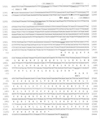Characterization and nucleotide sequence of a Klebsiella oxytoca cryptic plasmid encoding a CMY-type beta-lactamase: confirmation that the plasmid-mediated cephamycinase originated from the Citrobacter freundii AmpC beta-lactamase
- PMID: 10348751
- PMCID: PMC89277
- DOI: 10.1128/AAC.43.6.1350
Characterization and nucleotide sequence of a Klebsiella oxytoca cryptic plasmid encoding a CMY-type beta-lactamase: confirmation that the plasmid-mediated cephamycinase originated from the Citrobacter freundii AmpC beta-lactamase
Abstract
Plasmid pTKH11, originally obtained by electroporation of a Klebsiella oxytoca plasmid preparation into Escherichia coli XAC, expressed a high level of an AmpC-like beta-lactamase. The enzyme, designated CMY-5, conferred resistance to extended-spectrum beta-lactams in E. coli; nevertheless, the phenotype was cryptic in the K. oxytoca donor. Determination of the complete nucleotide sequence of pTKH11 revealed that the 8,193-bp plasmid encoded seven open reading frames, including that for the CMY-5 beta-lactamase (blaCMY-5). The blaCMY-5 product was similar to the plasmidic CMY-2 beta-lactamase of K. pneumoniae and the chromosomal AmpC of Citrobacter freundii, with 99.7 and 97.0% identities, respectively; there was a substitution of phenylalanine in CMY-5 for isoleucine 105 in CMY-2. blaCMY-5 was followed by the Blc and SugE genes of C. freundii, and this cluster exhibited a genetic organization identical to that of the ampC region on the chromosome of C. freundii; these results confirmed that C. freundii AmpC was the evolutionary origin of the plasmidic cephamycinases. In the K. oxytoca host, the copy number of pTKH11 was very low and the plasmid coexisted with plasmid pNBL63. Analysis of the replication regions of the two plasmids revealed 97% sequence similarity in the RNA I transcripts; this result implied that the two plasmids might be incompatible. Incompatibility of the two plasmids might explain the cryptic phenotype of blaCMY-5 in K. oxytoca through an exclusion effect on pTKH11 by resident plasmid pNBL63.
Figures






Similar articles
-
Characterization of the plasmidic beta-lactamase CMY-2, which is responsible for cephamycin resistance.Antimicrob Agents Chemother. 1996 Jan;40(1):221-4. doi: 10.1128/AAC.40.1.221. Antimicrob Agents Chemother. 1996. PMID: 8787910 Free PMC article.
-
Comparative characterization of the cephamycinase blaCMY-1 gene and its relationship with other beta-lactamase genes.Antimicrob Agents Chemother. 1996 Aug;40(8):1926-30. doi: 10.1128/AAC.40.8.1926. Antimicrob Agents Chemother. 1996. PMID: 8843306 Free PMC article.
-
Emergence of a cefepime- and cefpirome-resistant Citrobacter freundii clinical isolate harbouring a novel chromosomally encoded AmpC beta-lactamase, CMY-37.Int J Antimicrob Agents. 2008 Sep;32(3):256-61. doi: 10.1016/j.ijantimicag.2008.04.019. Epub 2008 Jul 10. Int J Antimicrob Agents. 2008. PMID: 18619820
-
CMY-31 and CMY-36 cephalosporinases encoded by ColE1-like plasmids.Antimicrob Agents Chemother. 2009 Mar;53(3):1256-9. doi: 10.1128/AAC.01284-08. Epub 2008 Dec 22. Antimicrob Agents Chemother. 2009. PMID: 19104021 Free PMC article.
-
Plasmid-encoded AmpC beta-lactamases: how far have we gone 10 years after the discovery?Yonsei Med J. 1998 Dec;39(6):520-5. doi: 10.3349/ymj.1998.39.6.520. Yonsei Med J. 1998. PMID: 10097678 Review.
Cited by
-
Characterization of pKP-M1144, a Novel ColE1-Like Plasmid Encoding IMP-8, GES-5, and BEL-1 β-Lactamases, from a Klebsiella pneumoniae Sequence Type 252 Isolate.Antimicrob Agents Chemother. 2015 Aug;59(8):5065-8. doi: 10.1128/AAC.00937-15. Epub 2015 Jun 1. Antimicrob Agents Chemother. 2015. PMID: 26033721 Free PMC article.
-
Moraxella Species as Potential Sources of MCR-Like Polymyxin Resistance Determinants.Antimicrob Agents Chemother. 2017 May 24;61(6):e00129-17. doi: 10.1128/AAC.00129-17. Print 2017 Jun. Antimicrob Agents Chemother. 2017. PMID: 28320720 Free PMC article.
-
CMY-16, a novel acquired AmpC-type beta-lactamase of the CMY/LAT lineage in multifocal monophyletic isolates of Proteus mirabilis from northern Italy.Antimicrob Agents Chemother. 2006 Feb;50(2):618-24. doi: 10.1128/AAC.50.2.618-624.2006. Antimicrob Agents Chemother. 2006. PMID: 16436718 Free PMC article.
-
Evidence for transfer of CMY-2 AmpC beta-lactamase plasmids between Escherichia coli and Salmonella isolates from food animals and humans.Antimicrob Agents Chemother. 2001 Oct;45(10):2716-22. doi: 10.1128/AAC.45.10.2716-2722.2001. Antimicrob Agents Chemother. 2001. PMID: 11557460 Free PMC article.
-
New method for laboratory detection of AmpC beta-lactamases in Escherichia coli and Klebsiella pneumoniae.J Clin Microbiol. 2004 Oct;42(10):4799-802. doi: 10.1128/JCM.42.10.4799-4802.2004. J Clin Microbiol. 2004. PMID: 15472344 Free PMC article.
References
-
- Bauernfeind A, Horl G. Novel R-factor born beta-lactamase of Escherichia coli conferring resistance to cephalosporins. Infection. 1987;15:257–259. - PubMed
-
- Bauernfeind A, Ang O, Bal C, Jungwirth R. Presented at the Scientific Meeting of the European Society of Chemotherapy, abstr. OC2. Coimbra, Portugal. 1994. Plasmidic cephamycinase gene in Citrobacter freundii transferable to Klebsiella pneumoniae and Escherichia coli.
-
- Bauernfeind A, Schweighart S, Dornbusch K, Giamarellou H. Program and abstracts of the 30th Interscience Conference on Antimicrobial Agents and Chemotherapy. Washington, D.C: American Society for Microbiology; 1990. A transferable cephamycinase (CMY-ase) in Klebsiella pneumoniae (K. pn.), abstr. 190; p. 118.
Publication types
MeSH terms
Substances
Associated data
- Actions
- Actions
LinkOut - more resources
Full Text Sources

